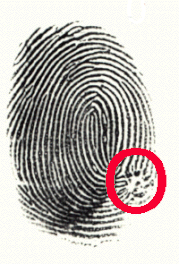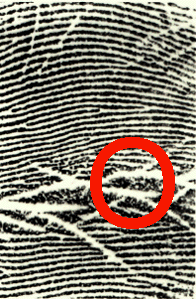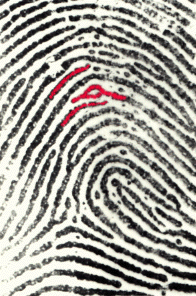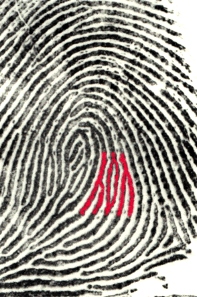"Target" of Friction Ridge Features
Scar as a "Target"
This scar displays disruption to the friction ridges causing a 'puckering' of the ridges at the point of injury. This scar can be judged to be permanent, and is a proper candidate for a "target".
Crease as a "Target".
This distal transverse crease in the hypothenar region of this palm print exhibits promineance and clarity, qualifying it as a 'target'.
Minutiae Cluster as a "Target".
This cluster of minutiae uses an 'island' friction ridge feature as its focal point. Note its relative position (above and slightly to the left) and absolute position (determined by ridge count) in relationship to the core.
Minutiae Cluster as a "Target".
This cluster of minutiae uses an 'alternating' pattern in the orientation of the bifurcations as its focal point. Note its relative position (to the right and slightly below) and absolute position (determined by ridge count) in relationship to the core.
"Target" of Friction Ridge Features
In anticipation of searching the latent print impression to a known print, a "target" of friction ridge features is selected and memorized. The "target" could be an appealing cluster of minutiae distinguished in itself, or in its relationship to a focal point such as a core, delta or type line.
Other "targets" can be a prominent crease, wrinkle pattern or a distinctive scar present in the latent print impression. Be certain of the "permanence" of these friction ridge features. Friction ridge features such as warts, wrinkles and incipient ridges may be "occasional" in nature. Try to avoid the selection of a "target" which is likely to be a temporary feature, and may not be present in the known print.
An injury to the skin which is deep enough to penetrate to the dermal papillae level can damage the epidermal basal layer. This extent of injury destroys its ability to regenerate the shape, appearance and orientation of the friction ridge features. The result is the appearance of a permanent scar at the skin's surface. Disruptions and deformations of the friction ridges and their ridge flow are indications of permanent scarring.
These types of friction ridge features serve as good "targets" for searching the latent print impression to the known print in the Comparison phase of the ACE-V methodology. The examiner must be aware that the selected scar may not have been present in the known print when it was recorded.
Other "targets" can be a prominent crease, wrinkle pattern or a distinctive scar present in the latent print impression. Be certain of the "permanence" of these friction ridge features. Friction ridge features such as warts, wrinkles and incipient ridges may be "occasional" in nature. Try to avoid the selection of a "target" which is likely to be a temporary feature, and may not be present in the known print.
An injury to the skin which is deep enough to penetrate to the dermal papillae level can damage the epidermal basal layer. This extent of injury destroys its ability to regenerate the shape, appearance and orientation of the friction ridge features. The result is the appearance of a permanent scar at the skin's surface. Disruptions and deformations of the friction ridges and their ridge flow are indications of permanent scarring.
These types of friction ridge features serve as good "targets" for searching the latent print impression to the known print in the Comparison phase of the ACE-V methodology. The examiner must be aware that the selected scar may not have been present in the known print when it was recorded.



